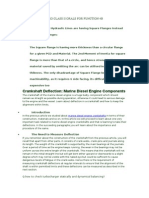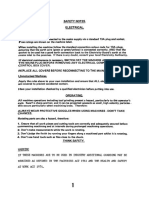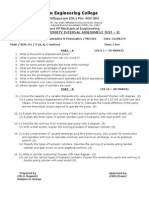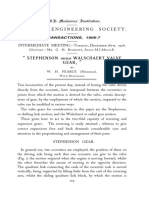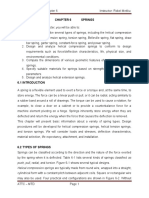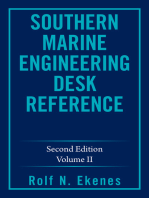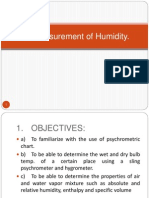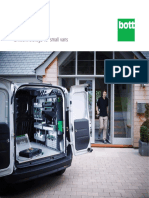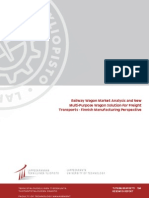Reaction and Friction Units: Classroom Manual Objectives Shop Manual Objectives
Reaction and Friction Units: Classroom Manual Objectives Shop Manual Objectives
Uploaded by
Jerico LlovidoCopyright:
Available Formats
Reaction and Friction Units: Classroom Manual Objectives Shop Manual Objectives
Reaction and Friction Units: Classroom Manual Objectives Shop Manual Objectives
Uploaded by
Jerico LlovidoOriginal Description:
Original Title
Copyright
Available Formats
Share this document
Did you find this document useful?
Is this content inappropriate?
Copyright:
Available Formats
Reaction and Friction Units: Classroom Manual Objectives Shop Manual Objectives
Reaction and Friction Units: Classroom Manual Objectives Shop Manual Objectives
Uploaded by
Jerico LlovidoCopyright:
Available Formats
Chapter 9 Reaction and Friction Units
Upon completion and review of this chapter, the student should be able to: Classroom Manual Objectives
Shop Manual Objectives
Describe the purpose and operation of the common reaction members. Explain how a bra e band wor s and what its purpose is. !dentif" the basic components in a h"draulic servo and describe their function. Describe the different t"pes of one#wa" clutches used in automatic transmissions. Explain how a roller#t"pe or spra$#t"pe, one#wa" clutch wor s. !dentif" the components in a h"draulic multiple disc clutch and describe their function. Describe the conditions re%uired for automatic shiftin$. &ist the conditions that ma" have an effect on shift feel. Explain the purpose and operation of an accumulator and modulator valve.
!nspect and replace bands and drums. 'd(ust bands, internall" and externall". !nspect and replace servo includin$ bore, piston, seals, pin, sprin$, and retainers and repair or replace as necessar". !nspect an accumulator bore, piston, seals, sprin$, and retainers, while the transmission is in or out of the vehicle. !nspect and service clutch drum, piston, chec #balls, sprin$s, retainers, seals, and friction and pressure plates. )easure and ad(ust clutch pac clearance. 'ir test the operation of the clutch pac and servo assemblies. !nspect and service roller and spra$ clutch, races, rollers, spra$s, sprin$s, ca$es, and retainers.
*verview
+his chapter in both manuals covers the construction, purpose, and service of the various clutches and bra es used in transmissions and transaxles.
Reading Assignments
Classroom )anual, pa$es ,-.#/01hop )anual, pa$es /2.#30/
Terms to Know Cantilever Fulcrum 1plit#band
59
Clutch volume index 4C5!6 Coast Dual band
*ver#center sprin$ 7ressure plate 1elective servo appl" pins
1teel discs 1teels +ransmission tune#up
&ecture *utline and 8otes
I. Objectives
Review the chapter9s ob(ectives.
II. Reaction Members
Discuss the importance of reaction members with re$ard to $ear ratio chan$es in the planetar" $earset.
III.
riction and Reaction !nits
Discuss the purposes of clutches and bra es and explain how each of them wor s to connect or hold members of the planetar" $earset.
I". #ra$e #ands
A. %urpose and Construction .. Describe the different t"pes of bands used and explain their applications. ,. Describe how bands are used and their operation. #. #and Service .. Describe $eneral inspection of the bands. ,. Describe band ad(ustment. /. Describe how drums should be chec ed.
". Servo and Accumulator
A. %urpose and Construction .. Describe the operation of a servo. ,. Describe the accumulator and its use. #. Servo and Accumulator Service .. Describe the disassembl" of the accumulator. ,. Describe how to disassemble the servo. /. Describe inspection of the servos and accumulators. 3. Describe the reassembl" procedure. :. Describe the method of measurin$ for the correct selective servo pin. ;. Discuss seal removal and inspection.
"I. One&'a( Clutches and #ra$es
'. Describe an overrunnin$ clutch and its use. <. Describe and discuss the wa"s to chec a roller clutch.
60 Instructors Guide to Accompany Todays Technician: Automatic Transmissions & Transaxles 3E
C. Describe and discuss the wa"s to chec a spra$ clutch.
"II.Multiple& riction )isc Clutch and #ra$e Assemblies
A. Multiple& riction )isc %ac$s Describe the purpose of the multiple#disc pac s found in transmissions, emphasi=e that the" can be used to connect and bra e $earset members, and describe how their purpose can be identified b" their placement in the transmission. #. Construction .. Describe the individual parts that ma e up a multiple#disc pac . ,. Describe the different t"pes of sprin$ used in multiple#disc pac s. C. Service .. Describe the disassembl" of the multiple#disc pac assembl". ,. Describe the $eneral inspection of multiple#disc pac s. /. Describe the reassembl" procedure. 3. Describe how to ma e clearance chec s on a multiple#disc pac assembl". :. Describe how to air test a multiple#disc pac assembl" and servos. ). Clutch "olume Inde* Discuss C5! in terms of efficienc".
"III. +ear Changes
A. Shi,t eel Describe the necessit" for proper shift feel and how it is accomplished. #. Shi,t -ualit( .. Describe what is meant b" shift %ualit". ,. Describe the wa"s shift %ualit" can be chan$ed.
I.. Summar(
Review the material covered, emphasi=in$ the main points and e" words.
Chapter 9 'nswers to Review >uestions
C&'11R**) )'8U'&, 7'?E1 /0-#/.0
Short Answer /ssa(s
0. Reaction members are those parts of a planetar" $earset that are held in order to produce an output motion. *ther members of the planetar" $earset react a$ainst the stationar" or held member.
Instructors Guide to Accompany Todays Technician: Automatic Transmissions & Transaxles 3E 61
1. <ecause of the location of the servo and band anchor, the band becomes self#ener$i=ed and wraps itself around the drum in the same direction as drum rotation. +his self#ener$i=in$ effect reduces the force that the servo must produce to hold the band. 2. ' multiple#disc pac also contains one or more return sprin$s, return sprin$ retainers, seals, one or more pressure plates, and snap rin$s. +he seals hold in the h"draulic pressure durin$ application of the pac . ' pressure plate is a heav" metal plate that provides the clampin$ surface for the plates and is installed at one end or both ends of the pac . +he snap rin$s are used to hold the parts in the pac to$ether. !n a t"pical pac , the appl" piston at the rear of the drum is held in place b" the return sprin$s and a sprin$ retainer secured b" a snap rin$. @"draulic pressure moves the piston a$ainst return sprin$ pressure and clamps the plates a$ainst the pressure plate. +he friction between the plates loc s them to$ether, causin$ them to turn as a unit. 3. +he multiple#friction disc pac can be used to drive or hold a member of the planetar" $earset b" connectin$ the member to the transmission9s case or to a clutch drum. 4. +wo t"pes of sin$le#wrap bands are commonl" used in transmissions toda". *ne t"pe is made of li$ht and flexible steel and the other t"pe is made of heav" and more ri$id cast iron. +he heav" bands are t"picall" made with a metallic linin$ material that can withstand lar$e $rippin$ pressures. &i$ht bands are lined with a less#abrasive material that helps limit drum wear. 5. ' <elleville sprin$ acts to improve the clampin$ force of the assembl", and as a piston return sprin$. +he sprin$ is loc ed into a $roove inside the drum b" a snap rin$. 's the piston moves to appl" the pac , it moves the inner ends of the <elleville sprin$ fin$ers into contact with the pressure plate to appl" the assembl". +he sprin$9s fin$ers act as levers a$ainst the pressure plate and increase the application force of the pac . Ahen h"draulic pressure to the piston is stopped, the sprin$ relaxes and returns to its ori$inal shape. +he piston is forced bac , and the pac is released. 6. 'ccumulators rel" on the action of a piston or a valve to dela" the deliver" of hi$h pressure to a clutch or band. 'n accumulator wor s li e a shoc absorber and cushions the application of servos and disc pac s. 'n accumulator cushions sudden increases in h"draulic pressure b" temporaril" divertin$ some of the appl" fluid into a parallel circuit or chamber. +his allows the pressure to $raduall" increase and provides for smooth en$a$ement of a bra e or clutch. 7. B1hift FeelC is controlled b" the pressure at which each reaction member is applied or released, the rate at which each is pressuri=ed or exhausted, and the relative timin$ of the appl" and release of the members. !t is also affected b" fluid t"pe, the momentar" en$a$ement of a component in a different circuit, pulsed pressures, the clearance of the appl" devices, and man" more desi$n features of the various transmission models. 8. ' roller clutch utili=es roller bearin$s held in place b" sprin$s to separate the inner and outer races of the clutch assembl". 'round the inside of the outer race are several cam#shaped indentations. +he rollers and sprin$s are located in these poc ets. Rotation of one race in one direction loc s the rollers between the two races, causin$ both to rotate to$ether. Ahen a race is rotated in the opposite direction, the roller bearin$s move into the poc ets and are not loc ed between the races. ' one#wa" spra$ clutch consists of a hub and a drum separated b" fi$ure# ei$ht#shaped metal pieces called spra$s. +he spra$s are shaped in such a manner that the" loc between the races when a race is turned in one direction onl". <etween the inner and outer races of the clutch are the spra$s, ca$es, and sprin$s. +he spra$s are lon$er than the distance between the two races. +he ca$es eep the spra$s e%uall" spaced around the diameter of the races. +he sprin$s hold the spra$s at the correct an$le and maintain contact of the spra$s with the races for instantaneous en$a$ement. Ahen a race turns in one direction, the spra$s tilt and
62 Instructors Guide to Accompany Todays Technician: Automatic Transmissions & Transaxles 3E
allow the races to move independentl". Ahen a race is moved in the opposite direction, the spra$s strai$hten up and loc the two races to$ether. 09. ' band is applied h"draulicall" b" a servo unit. +he servo contracts the band when h"draulic pressure pushes a$ainst the servo9s piston and overcomes the tension of the servo9s return sprin$. +his action moves an operatin$ rod toward the band, which s%uee=es the band around the drum.
ill&in&the&#lan$s
0. 1un, rin$ 1. Double#wrap, sin$le#wrap 2. ?overnor, throttle, throttle 3. Centrifu$al chec ball relief 4. Coil, small coil, <elleville 5. 1trai$ht, lever, cantilever 6. Drivin$ 7. 1urface area 8. Drivin$ device, splined, splined, to$ether, the same speed 09. Reaction members
Multiple Choice
0. C 1. ' 2. ' 3. C 4. ' 5. ' 6. C 7. < 8. C 09. C
1@*7 )'8U'&, 7'?E1 30/#303
AS/&St(le Review -uestions
0. < 1. C 2. C 3. D 4. C
Instructors Guide to Accompany Todays Technician: Automatic Transmissions & Transaxles 3E 63
5. < 6. D 7. ' 8. C 09. <
AS/ Challenge -uestions
0. ' 1. C 2. C 3. C 4. '
64 Instructors Guide to Accompany Todays Technician: Automatic Transmissions & Transaxles 3E
You might also like
- Air Control 3: ManualDocument72 pagesAir Control 3: ManualNihat RustamliNo ratings yet
- ASAL Psychology CB Unit 3 2nd SampleDocument36 pagesASAL Psychology CB Unit 3 2nd SampleMusonda K. BensonsNo ratings yet
- Air Compressor Using Crank and Slotted Link MechanismDocument22 pagesAir Compressor Using Crank and Slotted Link MechanismSaravanan Viswakarma75% (4)
- F-22 Service Manual PDFDocument75 pagesF-22 Service Manual PDFMario Sche100% (1)
- Safety NorthernDocument18 pagesSafety NorthernPolinho DonacimentoNo ratings yet
- Flash and Fire Points of Liquid Fuels and Grease Drop TestDocument27 pagesFlash and Fire Points of Liquid Fuels and Grease Drop TestJerico Llovido0% (2)
- Dynamometer and Power MeasurementDocument26 pagesDynamometer and Power MeasurementJerico LlovidoNo ratings yet
- Calibration and Use of Pressure and Temperature Measuring InstrumentsDocument52 pagesCalibration and Use of Pressure and Temperature Measuring InstrumentsJerico Llovido67% (3)
- Calibration of Platform ScaleDocument28 pagesCalibration of Platform ScaleJerico Llovido55% (11)
- Emergency PreparednessDocument46 pagesEmergency PreparednessBosh Cosh TrainingsNo ratings yet
- Bis Hallmark DelhiDocument99 pagesBis Hallmark DelhiGirish SinghNo ratings yet
- Lesson Plan 1Document8 pagesLesson Plan 1api-275769688100% (1)
- PulleyDocument9 pagesPulleypedropicapiedrantomeNo ratings yet
- Conveyor Belt InstallationsDocument95 pagesConveyor Belt InstallationsCarlos Andrés Aguilar OrozcoNo ratings yet
- Nodular Cast Iron, and A Ram. Each Pair of Cylinders Is Tied Together Axially by A Guide Bar and Adjacent Cylinders AreDocument10 pagesNodular Cast Iron, and A Ram. Each Pair of Cylinders Is Tied Together Axially by A Guide Bar and Adjacent Cylinders AreKr Manu100% (2)
- Proclimb Procross Torsional Conversion KitDocument8 pagesProclimb Procross Torsional Conversion KitcpcracingNo ratings yet
- UD 6 Mechanisms - Gears and Pulleys.Document10 pagesUD 6 Mechanisms - Gears and Pulleys.Sergio Ruiz ArranzNo ratings yet
- Function 4b OralsDocument13 pagesFunction 4b OralsSumeet SawantNo ratings yet
- Maintenance and Repair of Centrifugal PumpsDocument4 pagesMaintenance and Repair of Centrifugal Pumpsaserf251No ratings yet
- Experiment No. 23Document7 pagesExperiment No. 23KS RajawatNo ratings yet
- Anchor NomenclatureDocument23 pagesAnchor Nomenclaturenavalzero910No ratings yet
- OBJECT: To Study of A Lathe Gear Box. TheoryDocument5 pagesOBJECT: To Study of A Lathe Gear Box. TheoryThe AIRS CreationsNo ratings yet
- AnchorrescueDocument10 pagesAnchorrescuegregoire de BrichambautNo ratings yet
- Installation: A.E RreDocument1 pageInstallation: A.E Rresopian320No ratings yet
- Tr1. Coveñas Suyon JeancarloDocument16 pagesTr1. Coveñas Suyon JeancarloJean Cobeñas suyónNo ratings yet
- Anchor and Anchor ChainDocument21 pagesAnchor and Anchor ChainVaibhav Desai100% (2)
- Oral TipsDocument147 pagesOral TipsRaj MalikNo ratings yet
- Pages From Festo - HydraulicsDocument19 pagesPages From Festo - HydraulicsDiego PerezNo ratings yet
- Fundamentals of Fluid Mechanics Chapter 12 TurbinesDocument44 pagesFundamentals of Fluid Mechanics Chapter 12 Turbinesalisnowkiss6570No ratings yet
- Wireline Surface EquipmentDocument14 pagesWireline Surface EquipmentAdenta Hadi Aranto75% (4)
- 2 Piece Threaded Steel Ball Valves Installation, Operation, & Maintenance GuideDocument2 pages2 Piece Threaded Steel Ball Valves Installation, Operation, & Maintenance GuideLucianNo ratings yet
- Braking System: FunctionDocument11 pagesBraking System: FunctionIsaiah LuleNo ratings yet
- TM9-1706 JXD Gas EnginesDocument331 pagesTM9-1706 JXD Gas Enginesferdockm100% (1)
- Main Bearing 'B & W'Document5 pagesMain Bearing 'B & W'aliakbar tavafiNo ratings yet
- Trade Theory 2 Electronics MechanicDocument439 pagesTrade Theory 2 Electronics MechanicChittaranjan SethiNo ratings yet
- Principles of Centrifugal Pump Construction PDFDocument38 pagesPrinciples of Centrifugal Pump Construction PDFAjit KumarNo ratings yet
- (OPEL) Manual de Taller Opel Astra 2002 PDFDocument7 pages(OPEL) Manual de Taller Opel Astra 2002 PDFG TNo ratings yet
- Dissertation Roller BearingDocument16 pagesDissertation Roller Bearingparthp5423No ratings yet
- Steam Turbine Overhaul1Document44 pagesSteam Turbine Overhaul1mister pogi100% (5)
- Cowells Manuals PDFDocument16 pagesCowells Manuals PDFpedjaNo ratings yet
- WWW 018999Document39 pagesWWW 018999Andhie OsloNo ratings yet
- It-Ii AhpDocument1 pageIt-Ii AhpVignesh KumarNo ratings yet
- Valve Refacing and Valve Seat Grinding and Checking of Leakage of Valves.Document5 pagesValve Refacing and Valve Seat Grinding and Checking of Leakage of Valves.Karanbir Singh0% (1)
- Lathes and Lathe Machining OperationsDocument11 pagesLathes and Lathe Machining OperationsJunayed HasanNo ratings yet
- Motor Volkswagen GolfDocument22 pagesMotor Volkswagen GolfcarbutzNo ratings yet
- Schramm Chain AdjustmentDocument4 pagesSchramm Chain AdjustmentRafaelNo ratings yet
- Lathe Machine PrinciplesDocument15 pagesLathe Machine Principlesscratch89No ratings yet
- Lesson Positive Displacement Pumps Parts List & Function: Sub ObjectiveDocument14 pagesLesson Positive Displacement Pumps Parts List & Function: Sub Objectivemister pogiNo ratings yet
- 93FWD 6Document10 pages93FWD 6Luis Oswaldo Roa PerezNo ratings yet
- Lesson Guide For Periodic InspectionDocument3 pagesLesson Guide For Periodic Inspectionmister pogi100% (1)
- Anchoring, Mooring and Towing PDFDocument16 pagesAnchoring, Mooring and Towing PDFkullanici2010No ratings yet
- Stephenson Versus Walschaert Vlave GearDocument16 pagesStephenson Versus Walschaert Vlave Gearmaes.daan1No ratings yet
- KOM SolutionDocument2 pagesKOM SolutionJay SrivastavaNo ratings yet
- Alignment Course PDFDocument29 pagesAlignment Course PDFahmedbeaet80% (5)
- Kinematics and Dynamics of Machinery - Experiments PDFDocument47 pagesKinematics and Dynamics of Machinery - Experiments PDFUtkarsh SinghNo ratings yet
- Lesson Valve Maintenance and Valve Packing: Sub-ObjectiveDocument30 pagesLesson Valve Maintenance and Valve Packing: Sub-Objectivemister pogi100% (1)
- Title Demonstrate and Apply Knowledge of Electro, Proportional, and Servo Hydraulic Components and Systems Level 5 Credits 20Document7 pagesTitle Demonstrate and Apply Knowledge of Electro, Proportional, and Servo Hydraulic Components and Systems Level 5 Credits 20S.i. FairusNo ratings yet
- Instruction Manual: Spring BalancerDocument7 pagesInstruction Manual: Spring Balancerjaskaran singhNo ratings yet
- Chapter 06 SpringsDocument14 pagesChapter 06 SpringsRobel Metiku0% (1)
- 4650 and 4850 Section 55Document100 pages4650 and 4850 Section 55josephmw0308No ratings yet
- Fundamentals of Pulley and WinchesDocument62 pagesFundamentals of Pulley and WinchesvikasgahlyanNo ratings yet
- SM 4 ExperimentsDocument19 pagesSM 4 ExperimentsSarath TejaNo ratings yet
- AT6602 - Chassis Component DesignDocument14 pagesAT6602 - Chassis Component Designpavanrane100% (3)
- Gearless Power Transmission For Skew Shafts (A SRRS Mechanism)Document12 pagesGearless Power Transmission For Skew Shafts (A SRRS Mechanism)चन्दनप्रसादNo ratings yet
- Reciprocating Compressor IIDocument59 pagesReciprocating Compressor IIAhmad Aloudah100% (4)
- 57d7734aed10a 1994-2000YamahaTimberwolfYFB250FWServiceManual PDFDocument341 pages57d7734aed10a 1994-2000YamahaTimberwolfYFB250FWServiceManual PDFMauro Andrés Segura CalderónNo ratings yet
- Machine ShopDocument22 pagesMachine ShopAbeer NasirNo ratings yet
- KSRTC Report Doc Format NsDocument32 pagesKSRTC Report Doc Format NsAndrea Perry50% (2)
- Southern Marine Engineering Desk Reference: Second Edition Volume IiFrom EverandSouthern Marine Engineering Desk Reference: Second Edition Volume IiNo ratings yet
- Written Exam BucengDocument2 pagesWritten Exam BucengJerico LlovidoNo ratings yet
- Psme QuizDocument9 pagesPsme QuizJerico LlovidoNo ratings yet
- 9,10,11Document6 pages9,10,11Jerico LlovidoNo ratings yet
- OBE Syllabus - ME 413 ME Lab 01Document3 pagesOBE Syllabus - ME 413 ME Lab 01Jerico Llovido100% (1)
- Technological Innovations:: Lordan Martinez Jeffrey Neil Barba Noli AvilaDocument33 pagesTechnological Innovations:: Lordan Martinez Jeffrey Neil Barba Noli AvilaJerico LlovidoNo ratings yet
- Application Form NEW ENROLLEEDocument2 pagesApplication Form NEW ENROLLEEJerico LlovidoNo ratings yet
- Compressed Air PlantDocument88 pagesCompressed Air PlantJerico LlovidoNo ratings yet
- Cloud and Pour Points TestDocument20 pagesCloud and Pour Points TestJerico LlovidoNo ratings yet
- Measurement of HumidityDocument27 pagesMeasurement of HumidityJerico LlovidoNo ratings yet
- Carbon Residue TestDocument34 pagesCarbon Residue TestJerico Llovido50% (2)
- OBE Syllabus - ME 424 - Fluid MachineryDocument3 pagesOBE Syllabus - ME 424 - Fluid MachineryJerico LlovidoNo ratings yet
- Bicol University TOS - ME LAB 1 - MidtermDocument1 pageBicol University TOS - ME LAB 1 - MidtermJerico LlovidoNo ratings yet
- OBE Syllabus - ME 521 - Power Plant DesignDocument4 pagesOBE Syllabus - ME 521 - Power Plant DesignJerico LlovidoNo ratings yet
- Dose Measurements and Calculation PDFDocument19 pagesDose Measurements and Calculation PDFAlshuqaiq LaboratoryNo ratings yet
- Materi Song KirimDocument4 pagesMateri Song Kirimrane ajaNo ratings yet
- O B o Thay Chiõu Anh Vò ®êt S NG M GÇM L N Khóc ®éc H NHDocument9 pagesO B o Thay Chiõu Anh Vò ®êt S NG M GÇM L N Khóc ®éc H NHLê Thu HàNo ratings yet
- SKM 2009 TrainingDocument11 pagesSKM 2009 Trainingbal krishna dubeyNo ratings yet
- Lyrics of The Ordinary MassDocument6 pagesLyrics of The Ordinary Masslito77No ratings yet
- Modulo: Efficient Storage For Small VansDocument24 pagesModulo: Efficient Storage For Small VansLuís Filipe RochaNo ratings yet
- Rupam 10Document54 pagesRupam 10varnamala100% (1)
- Artaud, Antonin - Collected Works, Vol. 2 (Tr. Corti) (Calder & Boyars, 1971)Document242 pagesArtaud, Antonin - Collected Works, Vol. 2 (Tr. Corti) (Calder & Boyars, 1971)leroi77No ratings yet
- Understanding Raised Floor Systems For The Specifier 2016Document5 pagesUnderstanding Raised Floor Systems For The Specifier 2016Cristian Rae De TorresNo ratings yet
- 961 Annex B Form 1b Sample Harmonized WorkplanDocument2 pages961 Annex B Form 1b Sample Harmonized WorkplanRandell ManjarresNo ratings yet
- Japanese Dessert Recipes Gordon RockDocument62 pagesJapanese Dessert Recipes Gordon RockBorat Kaza100% (3)
- Practice Problems - Strema Part 3Document3 pagesPractice Problems - Strema Part 3Meverlyn RoqueroNo ratings yet
- FinalEnlistmentList16 03 2018completeDocument80 pagesFinalEnlistmentList16 03 2018completeRameez MustafaNo ratings yet
- A Compact Building Block With Two Shared-Aperture Antennas For Eight-Antenna MIMO Array in Metal-Rimmed SmartphoneDocument9 pagesA Compact Building Block With Two Shared-Aperture Antennas For Eight-Antenna MIMO Array in Metal-Rimmed Smartphonemujeeb.abdullah2830No ratings yet
- Intrinsic SemiconductorsDocument22 pagesIntrinsic SemiconductorsGilbertNo ratings yet
- Cell Injury and Cellular AdaptationDocument30 pagesCell Injury and Cellular AdaptationAngelita RuntukNo ratings yet
- Amoxicillin For Bacterial InfectionsDocument2 pagesAmoxicillin For Bacterial InfectionsWilliam ImpNo ratings yet
- Workshop Riazi Homepage EnglDocument10 pagesWorkshop Riazi Homepage Englabnou_223943920No ratings yet
- Askey rtl0200 5g NR Cpe DatasheetDocument2 pagesAskey rtl0200 5g NR Cpe DatasheetMSI IngenieriaNo ratings yet
- SCI 11 Module 5Document6 pagesSCI 11 Module 5Sebastian SmytheNo ratings yet
- Wagon Market StudyDocument153 pagesWagon Market Studytomhamnett100% (1)
- New York Times Article Domincia Hotel Roxys Mountian LodgeDocument4 pagesNew York Times Article Domincia Hotel Roxys Mountian Lodgeapi-243418619No ratings yet
- Answer: B: Selected/modified From Brown Et Al: Chemistry The Central Science, 10e, 12e, 13e TestbanksDocument10 pagesAnswer: B: Selected/modified From Brown Et Al: Chemistry The Central Science, 10e, 12e, 13e Testbanksفاطمة كليبNo ratings yet

















